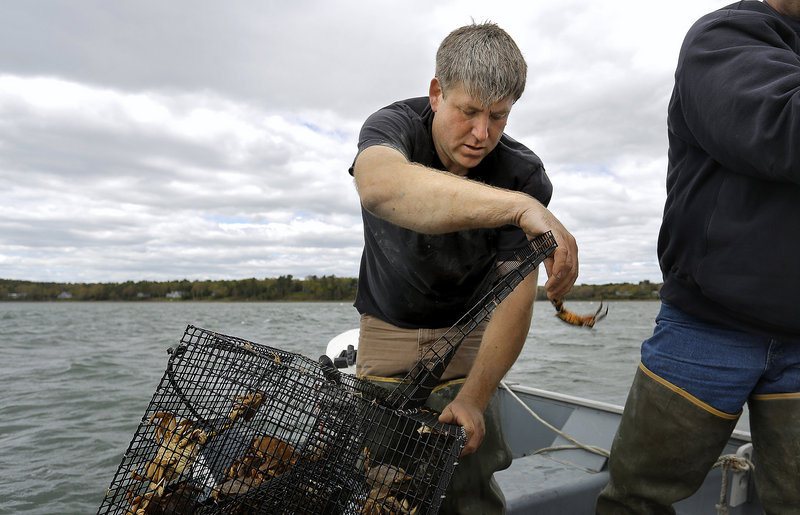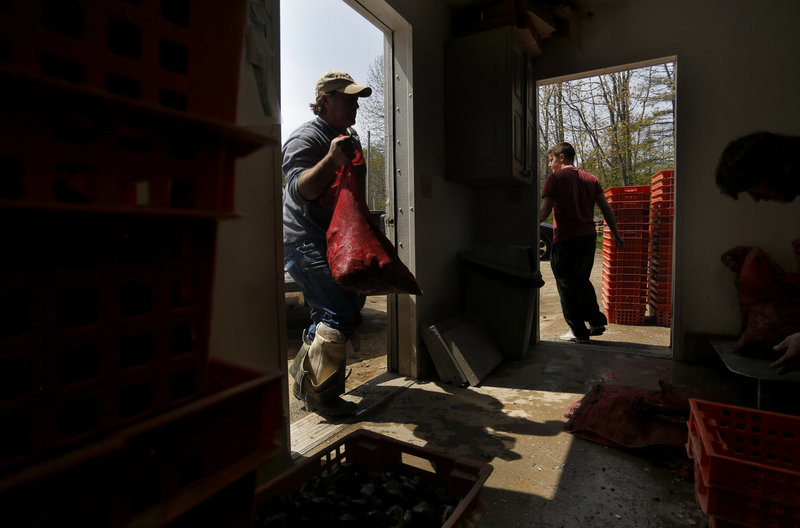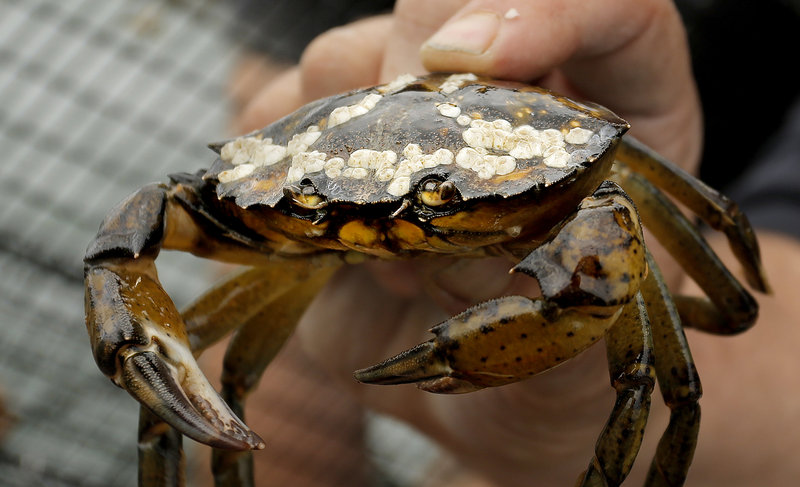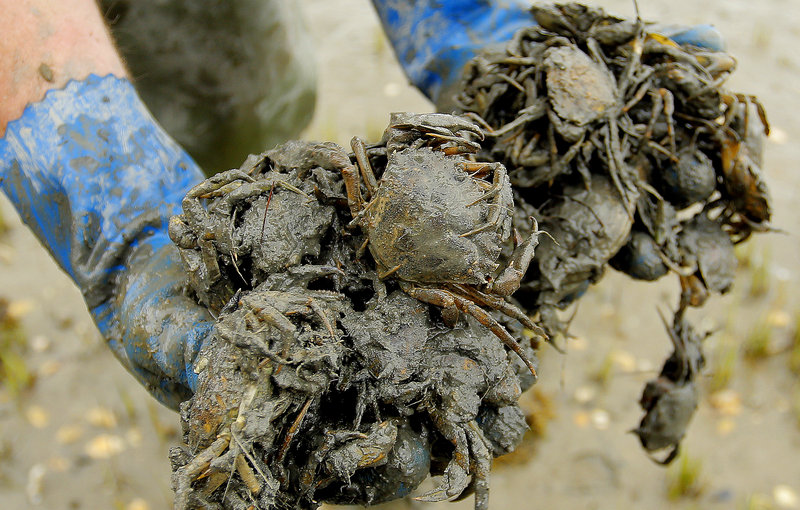FREEPORT – They lurk underfoot and in the shallows, waiting for the tide to take them to their prey.
Down by the thatch grass, dozens can be heard skittering and chittering in their nests.
In droves, they are conquering the clam flats, devouring soft-shell clams and taking a bite out of the livelihood of many in this town.
Green crabs — a hungry, multiplying army of them — present an impending crisis for clammers and their multimillion-dollar fishery.
“They’re consuming everything in the environment, even plants,” said Chad Coffin, president of the Maine Clammers Association, whose group is preparing an all-out offensive against the species.
“We may be facing the end of the commercially viable soft-shell (clam) population,” he said. “I think it is dire.”
Green crabs have been seen along southern Maine’s coast since 1904, but a recent confluence of mild winters and steadily warming waters has helped them thrive.
Clammers who have raked the mud flats for years say green crabs are quickly chewing through the clam beds, devouring the millimeters-wide baby clams known as “spat,” the foundation of future years’ harvests.
Scientists have by no means forgotten the crab, but academic funding to examine its effects or monitor its population is practically nil, said Brian Beal, the marine ecologist at the University of Maine who specializes in shellfish.
Now, the Town of Freeport will fund the first study on a meaningful scale to determine whether trapping, fencing and netting techniques are effective ways to stem the waves of the 10-legged invaders.
Three coves along the Harraseeket River will host multiple experiments overseen by Beal and an independent consultant, who will track crabs’ movement, numbers and effect on clams in the study area.
How are green crabs affecting the $25 million clamming industry, Maine’s third-largest fishery, with more than 1,700 registered diggers?
“That’s a great question, and it doesn’t really have a good answer because no one is tracking this stuff,” Beal said.
Freeport’s study, while small-scale relative to research efforts in other fisheries, shows the town’s willingness to acknowledge the prospect of a clamming collapse if trends continue unabated.
“For the first time, let’s do trapping and let’s do fencing and let’s do netting and combine all this stuff together,” Beal said.
The project will employ volunteer clammers who have agreed to fish 80 green-crab traps in the Harraseeket until November.
After Beal gets permits from the Army Corps of Engineers, he plans to install hundreds of feet of plastic fencing in the mud across the mouths of the coves to deter green crabs, which don’t swim and in theory cannot crawl through the barrier.
Inside the coves, Beal plans to stake off 50-foot-by-50-foot areas to determine how well fencing prevents crabs from entering and gauge the effectiveness of the various deterrents.
The town has committed about $65,000 this year to fund the work, and will likely consider continuing the study next season, said Beal.
The environmental factors that are believed to underlie green crabs’ population explosion mimic a micro-trend in the 1950s, believed to have been caused by mild weather.
The crabs were seen closer to shore and in sandy nests, rather than remaining in the intertidal areas where they usually live.
Coffin said the Maine Clammers Association is focusing on educating clammers and other fishermen about the crab’s threat to coastal ecosystems.
He said some are in denial. “A lot of fishermen don’t realize the impact these (crabs) have had. They say, ‘They’re not eating our clams.’ Well, what is?”
Coffin and his cohorts say they will soon reinvigorate the clammers association, which was founded in 2008 largely to pressure local shellfish authorities to open clam flats that had been closed for years.
The association lost its tax-exempt status this year after failing to file paperwork with the Internal Revenue Service for three consecutive years, said Nora Healy, a partner at the Verrill Dana law firm in Portland and a member of the Freeport Shellfish Commission.
She said a request has been made to reapply for nonprofit status.
Coffin said the loss of the tax exemption won’t hamper his effort to spread the word about the crab problem.
Denis-Marc Nault, a municipal shellfish management supervisor, said the state Department of Marine Resources has limited ability to manage the predation, but it has worked to grant permits for trapping crabs to a half-dozens coastal towns, up from one or two permits in years past.
“It’s never been a concerted, long, hard effort,” said Nault. “We have no money in our budget, and that’s not really our job, to do a predator control program.”
Nault said the crabs are among many factors that influence shellfish populations. Milky ribbon worms, moon snails and shellfish blood disease also reduce the productivity of clam flats, he said.
According to scientists who study the Gulf of Maine, climate change is at the root of many issues along the coast.
Four of the eight wettest years in the last 115 years have been recorded since 2005, and that has pushed more fresh water into the Gulf of Maine, said William Balch, a senior research scientist at the Bigelow Laboratory for Ocean Sciences in East Boothbay.
Freshwater runoff reduces salinity and introduces solid materials that block sunlight, reducing the tiny phytoplankton that are the base of nutrients for virtually all sea life.
“If you shut off the bottom of the marine food web for four years straight, that will undoubtedly have an impact,” Balch said.
A rise in ocean surface temperatures of about .018 degrees Celsius a year from 1977 to 2010 has particularly suited green crabs, which thrive in warmer temperatures that more closely mirror conditions in their native Europe.
No scientific explanations change the reality for clammers, who may soon see a smaller harvest if crabs continue to destroy next year’s stock.
At best, a bright future may mean a perpetual fight again the shifting forces of nature.
To Coffin, who said he will continue to clam and educate others how to keep the shellfish population healthy, the task is clear: “We have a lot more crabs to kill.”
This story was updated at 11:30 a.m. May 28 to correct the spelling of the Harraseeket River.
Matt Byrne can be contacted at 791-6303 or at mbyrne@pressherald.com
Send questions/comments to the editors.








Comments are no longer available on this story